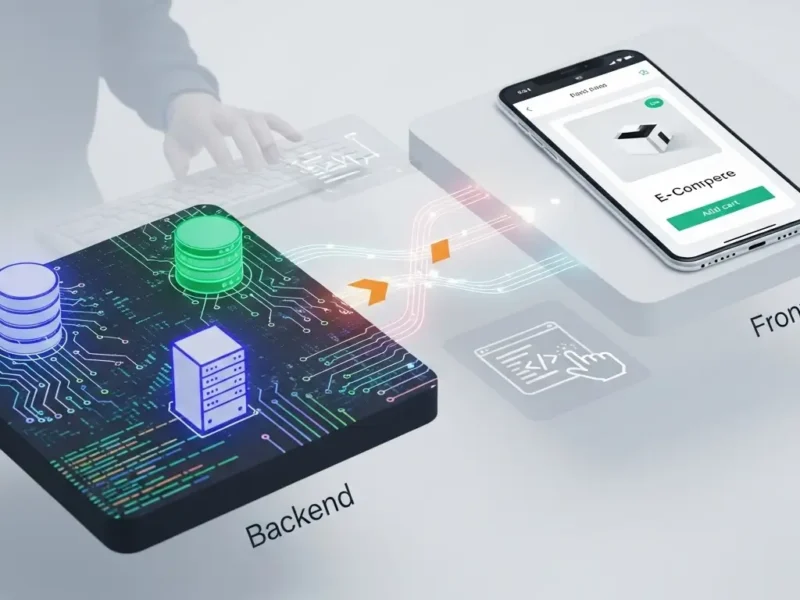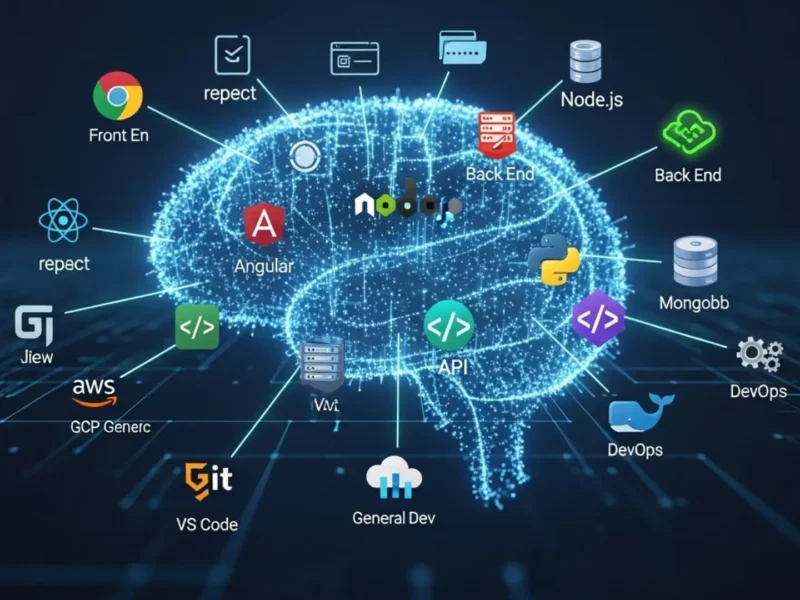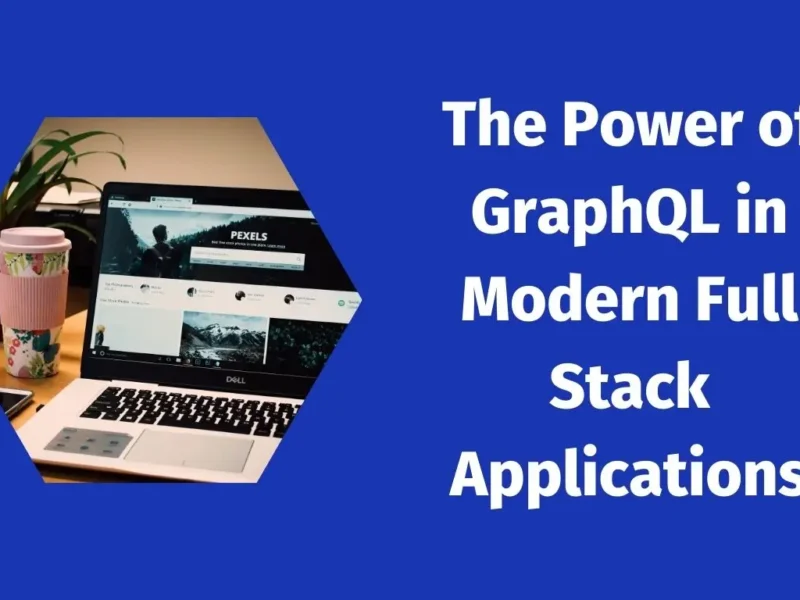The world of software development is in a perpetual state of evolution. But the current shift, driven by the seismic forces of Artificial Intelligence (AI) and automation, feels different. It’s not just an incremental update; it’s a fundamental reshaping of what it means to be a full stack developer. For years, the question has loomed: “Will AI replace developers?” The answer, we’re now realizing, is a resounding and nuanced “no.”
Instead, AI and automation are becoming the ultimate collaborators. They are powerful force multipliers, poised to eliminate tedium, accelerate workflows, and elevate the role of the full stack developer from a hands-on coder to a strategic architect. This article will dive deep into how these technologies are impacting every phase of the development lifecycle, what this means for the future of full stack development, and the critical skills you’ll need to not just survive, but thrive in this new era.
The Full Stack Developer’s Burden: A Pre-AI Snapshot
Before we look forward, let’s briefly look at the present. A full stack developer is the Swiss Army knife of the tech world, expected to be proficient across the entire technology stack. This versatility is why many businesses seek comprehensive full stack development services—they want a single team or individual who can own a project from conception to deployment. This proficiency typically includes:
- Frontend Development: Crafting user interfaces with HTML, CSS, and JavaScript frameworks like React, Angular, or Vue.
- Backend Development: Building server-side logic, APIs, and databases using languages like Node.js, Python, Java, or Ruby.
- Database Management: Working with SQL and NoSQL databases like PostgreSQL, MongoDB, and Redis.
- DevOps and Deployment: Managing cloud infrastructure, CI/CD pipelines, and ensuring applications are scalable and secure.
The challenge? The sheer breadth of this role leads to context-switching, battling boilerplate code, and spending countless hours on repetitive tasks like writing tests, debugging minor issues, and configuring deployment environments. This is precisely where AI and automation are making their grand entrance.
The AI Revolution: Impact Across the Full Stack Development Lifecycle
AI isn’t a single tool; it’s a spectrum of technologies being woven into the fabric of software creation. Its influence is felt from the initial idea to post-deployment monitoring.
Phase 1: AI-Powered Planning and Design
The development process doesn’t start with code; it starts with an idea. Traditionally, this phase involves manual market research, user story creation, and design mockups. AI is streamlining this entire process.
- Requirement Gathering: AI tools can analyze thousands of user reviews, support tickets, and social media comments to identify common pain points and feature requests. This data-driven approach helps teams prioritize what to build next, moving beyond guesswork.
- UI/UX Prototyping: Tools like Uizard and Galileo AI can generate entire UI mockups from simple text prompts. A developer can describe an app’s screen (“Create a login screen with a logo, email, password fields, and a ‘Sign in with Google’ button”), and the AI generates a high-fidelity, editable design in seconds. This dramatically accelerates the prototyping and feedback loop.
Phase 2: The Rise of the AI Coding Assistant
This is where the most visible transformation is happening. AI coding assistants are no longer a novelty; they are becoming standard-issue tools for modern developers.
GitHub Copilot, powered by OpenAI’s Codex, is the poster child of this movement. It doesn’t just autocomplete a single line; it understands the context of your entire file and project to suggest multi-line functions, complex algorithms, and even entire test suites.
How AI in full stack development helps here:
- Boilerplate Annihilation: Need to set up a standard Express server or a React component with state management? Copilot can generate the entire boilerplate structure with a single comment prompt, saving valuable time and reducing cognitive load.
- Learning and Exploration: When working with an unfamiliar library or API, a developer can simply write a comment describing what they want to achieve, and the AI will often provide a correct, idiomatic implementation. It acts as an interactive, on-demand tutor.
- Context-Aware Suggestions: Tools like Tabnine and Amazon’s CodeWhisperer learn from your specific coding style and your team’s codebase, providing highly relevant and personalized suggestions that adhere to your project’s conventions.
Phase 3: Automated Testing and Intelligent Debugging
Writing tests is crucial for code quality, but it’s often a time-consuming and repetitive task. Debugging can be even more frustrating—a hunt for a needle in a digital haystack.
- Automated Test Generation: AI tools can now analyze a function and automatically generate relevant unit tests, including edge cases that a human might overlook. This ensures better test coverage with a fraction of the manual effort.
- Intelligent Debugging: Instead of manually placing console.log statements everywhere, AI-powered debuggers can analyze stack traces, identify the root cause of an error, and in some cases, even suggest a fix. Tools like Sentry and Datadog are integrating AI to automatically group similar errors and surface critical performance issues before they impact users.
Phase 4: AIOps in Deployment and Monitoring
The DevOps pipeline is a prime candidate for automation, and adding AI to the mix (AIOps) creates a truly intelligent system.
- Optimized CI/CD Pipelines: AI can analyze deployment history to predict the risk of a new release. If a particular code change has a high probability of causing a failure, the system can flag it for additional review before it ever reaches production.
- Predictive Monitoring and Anomaly Detection: Traditional monitoring tools alert youaftera problem occurs. AIOps platforms use machine learning to establish a baseline of normal application behavior. They can then detect subtle anomalies—like a gradual memory leak or a slight increase in API latency—and alert developersbeforeit leads to a catastrophic outage.
The Power of Automation: Streamlining the Stack from End to End
While AI provides the “intelligence,” automation provides the “engine” that executes tasks reliably and repeatedly. The synergy between the two is what creates a hyper-efficient development environment.
Key Areas Where Automation is a Game-Changer
- Infrastructure as Code (IaC): Tools like Terraform and Pulumi allow developers to define their entire cloud infrastructure (servers, databases, networks) in configuration files. This makes environments perfectly reproducible, eliminates manual setup errors, and allows for version control of the infrastructure itself.
- Low-Code/No-Code (LCNC) Platforms: Platforms like Retool, Bubble and Webflow are democratizing development. While they won’t replace full stack developers, they empower them. A developer can now use a low-code platform to quickly build an internal admin panel or a simple CRUD app in hours instead of weeks, freeing them up to focus on the complex, core business logic that truly requires their expertise.
- Automated Security (DevSecOps): Security is no longer an afterthought. Automation integrates security scanning directly into the CI/CD pipeline. Tools can automatically scan code for vulnerabilities, check dependencies for known security issues, and perform dynamic application security testing (DAST) on every new build, making security a continuous, automated process.
The New Skillset: Evolving for the Future of Full Stack Development
The developer of tomorrow won’t be measured by lines of code written but by the value and solutions they architect. The role is shifting from a creator to an orchestrator, effectively evolving the long-standing debate of Full Stack Developer vs. Specialized Developers. With AI handling specialized, repetitive coding tasks, the full stack developer’s value is increasingly found in their broad, architectural oversight. To thrive in this new landscape, they must cultivate a new set of skills:
- Prompt Engineering and AI Collaboration: Learning how to “talk” to AI is becoming a critical skill. Crafting effective prompts to get the best results from tools like GitHub Copilot or UI generators is the new art form.
- AI/ML Integration: The focus will shift from building everything from scratch to intelligently integrating third-party AI services. Knowing how to connect an application to an image recognition API, a natural language processing service, or a recommendation engine will be invaluable.
- Strategic Problem-Solving: With AI handling the “how” (writing the code), developers can focus on the “what” and “why.” This means a deeper understanding of business goals, user needs, and system architecture. The most valuable developers will be those who can look at a business problem and design an elegant, scalable, and efficient technical solution, leveraging AI and automation as their primary tools.
- Mastery of AIOps and Automation Tools: Deep expertise in the tools that manage the automated ecosystem—Terraform, Kubernetes, CI/CD platforms, and AIOps monitoring solutions—will be a key differentiator.
The Human Element: Why Creativity and Critical Thinking Reign Supreme
For all their power, AI models are still just that—models. They are exceptionally good at pattern recognition and executing tasks based on the data they were trained on. They lack true understanding, consciousness, and creativity.
The human developer remains indispensable for:
- Innovation and Creativity: AI can replicate existing patterns, but it cannot invent a truly novel solution to a problem it has never seen before.
- Ethical Judgment: AI doesn’t understand the ethical implications of the code it writes. A human must be the final arbiter to ensure applications are fair, unbiased, and responsible.
- Understanding Business Context: A developer can sit in a meeting, understand the subtle nuances of a client’s request, and translate that human context into a technical blueprint. AI cannot.
- Complex System Design: Architecting a complex, multi-service system requires a holistic vision and foresight that is currently far beyond the capabilities of any AI.
Conclusion: Your New Role as a Full Stack Architect
The future of full stack development isn’t about being replaced; it’s about being augmented. AI and automation are not your competition; they are your most powerful new teammates. They are here to handle the repetitive, the mundane, and the predictable, freeing you to focus on the tasks that require uniquely human skills: creativity, strategic thinking, and complex problem-solving.
By embracing these tools, you transform your role. You move from being a coder to a solution architect, from a builder to a systems orchestrator. The future is bright for those who learn to wield these new powers, allowing them to build better, faster, and more sophisticated applications than ever before. The revolution is here—it’s time to lead it.



